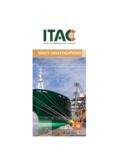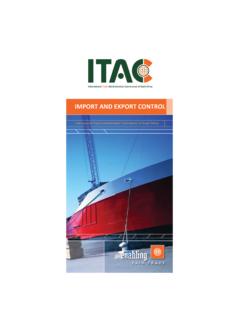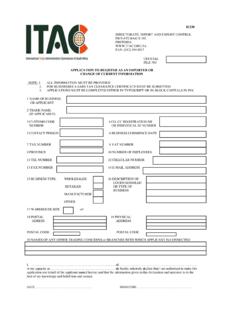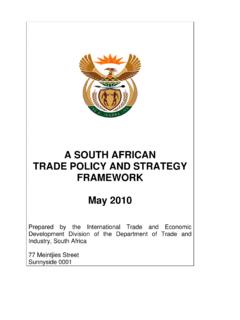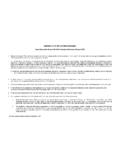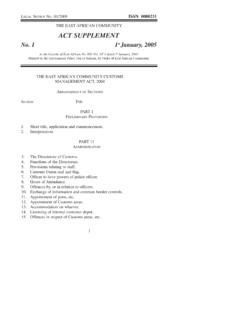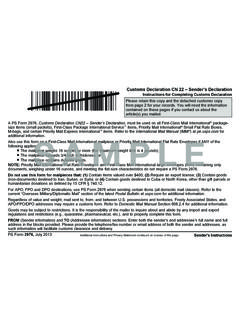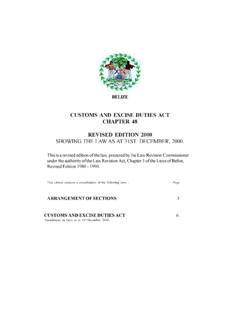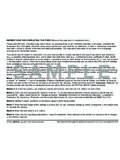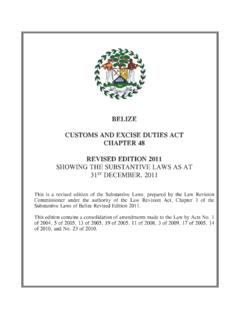Transcription of booklet itac (BLEED ONLY)
1 CONTENTS 03 Tari Investigations 10 Trade Remedies14 Import and Export Control 1 Mandate ITAC was established through an Act of Parliament, the International Trade Administration Act, (Act 71 of 2002), which came into force on 1 June aim of ITAC, as stated in the Act, is to foster economic growth and development in order to raise incomes and promote investment and employment in South Africa and within the Common Customs Union Area by establishing an e cient and e ective system for the administration of international trade subject to this Act and the Southern African Customs Union (SACU) Agreement.
2 The core functions are: customs tari investigations; trade remedies; and import and export Commission meets once a month to evaluate investigations conducted by its investigators and make recommendations to the Minister of Trade and Industry. The ITA Act provides for a full-time Chief Commissioner and Deputy Chief Commissioner and a maximum Chi ef Commissioner: Siyabulela Tsengiwe MANDATE, VISION, MISSION AND CORE VALUES International Trade Administration Commission of South Africa Vis ion An i nsti tuti on o f excellence i n i nte rnational t rade administrati on, enhancing economic g rowth a nd development. Mission IT AC aims to c reate a n e nabli ng e nvironment for fair trade through: Core Values ITAC is guided by the following set of core values: 2 submission for preliminary consideration by Commission Publication of an investigation through a Government Gazette notice Receive public comments from interested parties Commission makes final finding Submit a report with the recommendation to the Minister of Trade and Industry The Minister of Trade and Industry may accept or reject the recommendation If the Minister of Trade and Industry accept the recommendation to make an amendment, the Minister will request the Minister of Finance to implement the applications to ITAC for rebate or refund ofthe dutyITAC administers the export-promoting rebate provision drawback provision in Schedule and 5 of theCustoms and Excise Act.
3 This rebate or refund of duty is anincentive that allows manufacturers to source their materials andcomponents at world prices, thus improving their competitivenessin export markets. of ten Commissioners who can be appointed to serve on a part-time basis. The Commissioners come from diverse back grounds including: Economics, International Trade Law, Agriculture, Business and Labour. E cient and e ective administration of its trade instruments; and Technical a dvice t o t he Economic Development Department and the d ti. In te gri ty ; Trust; Accounta bility; and, Commitment. 3 The objectives of the Tariff Investiga-tions Unit are to promote, in a comple-mentary manner, domestic production, job retention and creation, and interna-tional competitiveness.
4 This is done by investigating applications for rebate and drawback permits and for tariff relief and support. The process of applications is rigorous and evidence-based and includes extensive research, verifica-tions, preparation of written submis-sions and assessment of the merit of the support is tied to conditions related to economic performance over time and is reviewed after a specified period. This means that tari amendments are conditional on a commitment by beneficiaries on how they will perform against government s set policy in the customs dutyTari increases are considered for the purpose of granting relief for domestic producers that may be experiencing threatening import pressures to adjust and restructure so that in the medium to long term these industries could become internationally competitive without any support in the form of customs duties.
5 This is made possible by the fact that there is a di erence between the applied rates and the WTO bound INVESTIGATIONS 4 Reduction in the customs dutyA reduction or removal of duties is considered on a case-by-case basis on resource-based inputs to lower input costs into labour intensive industries in order to increase global competitiveness and also in instances where goods, (consumption goods, intermediate goods or capital goods) are not manufactured domestically or unlikely to be manufactured or drawback of the customs dutyIn instances where a product is not produced or insu ciently produced domestically or not produced in the required specifications as an industrial or agricultural input for certain critical applications, a customs duty waiver can be provided, allowing for exemption of duty on products for which detailed separate tari lines are impracticable for tari administration rebate provisions introduced by ITAC over the years for a variety of products are standing rebate and drawback provisionsin schedules No.
6 3, 4 and 5 to the Customs and Excise Act and are administered by No. 3 makes provision for industrial rebates for manufacturing purposes, allowing manufacturers, including the motor vehicle and textile and clothing industries, to source their intermediate material and component inputs at world No. 4 makes provision for products for which there are temporary shortages on the domestic market, and generally also for consumption and capital goods for which separate tari lines are not No. 5 is similar to Schedule 3 and 4, except that drawbacks (refunds) of duties are provided for, not rebates, which requires that duties are paid first and then refunded after an investigation by Customs. 5 submission for preliminary consideration by Commission Publication of an investigation through a Government Gazette notice Receive public comments from interested parties Commission makes final finding Submit a report with the recommendation to the Minister of Trade and Industry The Minister of Trade and Industry may accept or reject the recommendation If the Minister of Trade and Industry accepts the recommendation to make an amendment, the Minister will request the Minister of Finance to implement the applications to ITAC for rebate or refund ofthe dutyITAC administers the export-promoting rebate provision drawback provision in Schedule and 5 of the Customs and Excise Act.
7 A number of provisions in Schedule 3, 4 and to a lesser exte nt Schedule 5 are intr oduced annually, whilst some are delete d when they no longer serv e the required purpose or if the duty has been reduced in Part 1 of Schedule of the Custome and Execise Act, 1964. Approximately 10% to 12% of all imports enter the country through the utilization of some or other rebate or dra wback time to finalise tariff investigations (Increase,Reduction and Creation of rebate of the customs duty)Generally it takes an average of 4 months for sectors in distressand 6 months for normal procedure for conducting tariff investigationsApplications for customs duty amendments are received fromindustry. ITAC may also decide to conduct proactive investiga-tions. All these applications go through the following stages: Application to ITAC A number of provisions in Schedule 3, 4 and to a lesser extent Schedule 5 are introduced annually, whilst some are deleted when they no longer serve the required purpose or if the duty has been reduced in Part 1 of Schedule of the Customs and Excise Act, 1964.
8 Approximately 10% to 12% of all imports enter the country through the utilization of some or other rebate or drawback time to nalise tari investigations (Increase, Reduction and Creation of rebate of the customs duty)Generally it takes an average of 4 months for sectors in distress and 6 months for normal procedure for conducting tari investigationsApplications for customs duty amendments are received from industry. ITAC may also decide to conduct proactive investigations. All these applications go through the following stages: Application to ITAC submission for preliminary consideration by Commission Publication of an investigation through a Government Gazette notice Receive public comments from interested parties Commission makes final finding Submit a report with the recommendation to the Minister of Trade and Industry The Minister of Trade and Industry may accept or reject the recommendation If the Minister of Trade and Industry accept the recommendation to make an amendment, the Minister will request the Minister of Finance to implement the applications to ITAC for rebate or refund ofthe dutyITAC administers the export-promoting rebate provision and drawback provision in Schedule and 5 of the Customs and Excise Act.
9 This rebate or refund of duty is an incentive that allows manufacturers to source their materials and components at world prices, thus improving their competitiveness in export markets. TARIFF INVESTIGATIONST urnaround time2 weeksAPDPThe Automotive Production and Development Programme (APDP) was implemented e ectively from 01 January 2013 and is aimed at creating an environment that will enable registered light motor vehicle manufacturers to significantly grow production volumes and component manufacturers to significantly grow value addition, leading to the creation of additional employment opportunities across the automotive value programme comprises the following four elements: tariffs Production Incentive (PI)This rebate or refund of duty is an incentive that allows manufacturers to source their materials and components at world prices, thus improving their competitiveness in export rebate provisions are also administered by ITAC on a permit basis instances where a product is not available in SACU in the required quantities or for assessing rebate and drawback permit applications Submit application to ITAC Adjudicate merits of the application Submission prepared for consideration by the delegated authority Approve/Reject application for rebate Volume Assembly Allowance (VAA) Automotive Investment Scheme (AIS)
10 ITAC administers the above-mentioned elements with the exception of the AIS, which is administered by the dti.(i) TariffsThis element of the APDP aims to keep customs duties stable at 25% for vehicles and 20% for automotive components for all registered entities. ii) Procedure for administering eligibility of products to qualify for PI Preliminary assessment of applications for eligibility Adjudication of applications for eligibility of products by the APDP Technical Working Group (TWG) Verification conducted if necessary Recommendation made by APDP TWG for consideration by delegated authorityiii) Procedure for administering rebate credit claims generated from PI Submission of claims by industry Verification of claims by delegated authority Issue Production Rebate Credit Certificate (PRCC)
